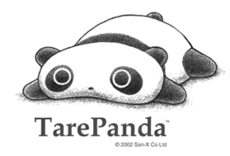
Tarepanda
Encyclopedia

Cuteness in Japanese culture
Since the 1970s, cuteness, in Japanese the noun , has become a prominent aspect of Japanese popular culture, entertainment, clothing, food, toys, personal appearance, behavior, and mannerisms...
panda
Giant Panda
The giant panda, or panda is a bear native to central-western and south western China. It is easily recognized by its large, distinctive black patches around the eyes, over the ears, and across its round body. Though it belongs to the order Carnivora, the panda's diet is 99% bamboo...
character owned by the company San-X
San-X
is a Japanese company that specializes in the creation, production and marketing of goods featuring cute characters such as Tarepanda, Rilakkuma, Kogepan and Afro Ken. The characters are usually anthropomorphic representations of animals or inanimate objects; the character Tissue-san was modelled...
. The term "tare" means "lazy" or "droopy" in Japanese
Japanese language
is a language spoken by over 130 million people in Japan and in Japanese emigrant communities. It is a member of the Japonic language family, which has a number of proposed relationships with other languages, none of which has gained wide acceptance among historical linguists .Japanese is an...
.
Creation
Tarepanda is licensed by San-XSan-X
is a Japanese company that specializes in the creation, production and marketing of goods featuring cute characters such as Tarepanda, Rilakkuma, Kogepan and Afro Ken. The characters are usually anthropomorphic representations of animals or inanimate objects; the character Tissue-san was modelled...
, the company that introduced Tarepanda stickers in 1995. It was designed by Hikaru Suemasa and was inspired by the Hikaru Suemasa being tired.
Characteristics
Tarepanda is a character that moves by rolling over, with a record speed of 2.75 m/h. Tarepanda's favorite food is mochiMochi
Mochi is a Japanese rice cake made of glutinous rice pounded into paste and molded into shape. In Japan it is traditionally made in a ceremony called mochitsuki. While also eaten year-round, mochi is a traditional food for the Japanese New Year and is commonly sold and eaten during that time...
, especially suama
Suama
, a combination of the kanji for celebration "su" and sweet "ama" is a Japanese sweet made of non-glutinous rice flour, hot water, and sugar characterized by its red food dye. It is dyed red, because red and white symbolize celebration in Japanese tradition...
.
Popularity
In February 1998, San-X launched Tarepanda erasers and letter pads, which proved enormous hits. San-X believed these products were successful because they were released shortly after the Asian financial crisis of autumn 1997, a time when many people in Japan were facing layoffs and, consequently, were sympathetic toward a "worn-out" panda character. By 1999, sales of Tarepanda goods had reached 30 billion yen. Character Databank, a Japanese character popularity monitoring firm, has claimed Tarepanda was a huge hit in Japan.Picture books
- Tarepanda: Kyou mo Yoku Tareteimasu. (Hikaru Suemasa, June 1999, ISBN 4096812110)
- Taregoyomi: Nengara Nenju Tareteimasu. (Hikaru Suemasa, September 1999, ISBN 4096812129)
- Taredzukushi: Tarepanda Fuanbukku (Hikaru Suemasa, March 2000, ISBN 4096812137)
- Tareyukumamani: Kigatsuku to Sobani iru (Hikaru Suemasa, April 2001, ISBN 4096812145)
Videos
- Tarepanda (Bandai VisualBandai Visual, is a Japanese anime, film production and distribution enterprise, established by Bandai Co., Ltd. and a subsidiary of Namco Bandai Holdings, Inc., which is based in Minato, Tokyo, Japan. Since the reorganisation of Namco Bandai Holdings in 2006, Bandai Visual now heads the group's Visual and...
, VHSVHSThe Video Home System is a consumer-level analog recording videocassette standard developed by Victor Company of Japan ....
, 2000/7/25) - Tarepanda (Bandai VisualBandai Visual, is a Japanese anime, film production and distribution enterprise, established by Bandai Co., Ltd. and a subsidiary of Namco Bandai Holdings, Inc., which is based in Minato, Tokyo, Japan. Since the reorganisation of Namco Bandai Holdings in 2006, Bandai Visual now heads the group's Visual and...
, DVDDVDA DVD is an optical disc storage media format, invented and developed by Philips, Sony, Toshiba, and Panasonic in 1995. DVDs offer higher storage capacity than Compact Discs while having the same dimensions....
, 2000/8/25)
Games
- Tarepanda no Gunpei (BandaiBandaiis a Japanese toy making and video game company, as well as the producer of a large number of plastic model kits. It is the world's third-largest producer of toys . Some ex-Bandai group companies produce anime and tokusatsu programs...
, WonderSwanWonderSwanwas a line of handheld game consoles produced in Japan by Bandai between 1999 and 2003. It was developed by the late Gunpei Yokoi's company Koto and Bandai...
, December 9, 1999) - Taregoro: Tarepanda no Iru Nichijou (Bandai, PlayStationPlayStationThe is a 32-bit fifth-generation video game console first released by Sony Computer Entertainment in Japan on December 3, .The PlayStation was the first of the PlayStation series of consoles and handheld game devices. The PlayStation 2 was the console's successor in 2000...
, August 31, 2000)
Computer
- Tarepanda (InterchannelInterchannelInterchannel is a Japanese game developer and publisher. Previously known as NEC Interchannel and before that NEC Avenue, it was originally a subsidiary of NEC before 70 percent of the company was sold to Index Corporation for approximately 3 billion yen in 2004...
, 2001/6/29, typing-tutor software) - Tare Tsuzuri (InterchannelInterchannelInterchannel is a Japanese game developer and publisher. Previously known as NEC Interchannel and before that NEC Avenue, it was originally a subsidiary of NEC before 70 percent of the company was sold to Index Corporation for approximately 3 billion yen in 2004...
, 2001/11/22, card-creation software) - Tarepanda Toissho (FortyfiveFortyfiveFortyfive Co. Ltd. is a Japanese software development company known for its Tokyo Bus Guide and other SEGA Dreamcast games. Prior to 1997 the studio was known as AIM.-Games as Fortyfive:*Communication Logic Battle Daisessen...
, 1999/4/16, desktop accessories) - Tarepanda Toissho 2 (FortyfiveFortyfiveFortyfive Co. Ltd. is a Japanese software development company known for its Tokyo Bus Guide and other SEGA Dreamcast games. Prior to 1997 the studio was known as AIM.-Games as Fortyfive:*Communication Logic Battle Daisessen...
, 1999/8/10, desktop accessories) - Tarepanda Toissho 3 (FortyfiveFortyfiveFortyfive Co. Ltd. is a Japanese software development company known for its Tokyo Bus Guide and other SEGA Dreamcast games. Prior to 1997 the studio was known as AIM.-Games as Fortyfive:*Communication Logic Battle Daisessen...
, 2000/4/28, desktop accessories) - Tarepanda Toissho Tsume Awa Se (FortyfiveFortyfiveFortyfive Co. Ltd. is a Japanese software development company known for its Tokyo Bus Guide and other SEGA Dreamcast games. Prior to 1997 the studio was known as AIM.-Games as Fortyfive:*Communication Logic Battle Daisessen...
, 2002/2/8, desktop accessories)

